
The introduction of any new generation of the Chevrolet Corvette is big news. But the 2014 Chevrolet Corvette Stingray with the Z51 package officially has my full attention.
Senior Editor Josh Jacquot and I were invited to drive early production samples at a sneak peek event at GM's Milford proving grounds, where we were turned loose to flog them on an autocross course set up on the PG's massive Black Lake. Later we pounded around the tricky "Lutzring" handling course as fast as we dared. Through it all the new C7 was disarmingly quick. The speed came easily, and neither of us ever got the sense of being on the razor's edge.
You should see the numbers. GM also allowed us to bring our Vbox along and conduct our usual battery of tests while they watched confidently from 500 yards away. They were fine as long as we didn't point our cameras at any diaper-clad prototypes we happened to see.
Josh promptly equaled GM's straight-line acceleration claims of a 12-second quarter-mile and zero to 60 mph in 3.8 seconds after excluding the same 1 foot of initial drag strip rollout they deduct. But rollout and zero mph are mutually exclusive concepts; the true zero-means-zero-to-60 figure is 4.1 seconds.
But this is a suspension walkaround. To that end Josh snaked the Z51 Stingray through the slalom cones (authentic Edmunds-spec ones he'd packed in his suitcase) at 72.8 mph. The new Vette's best stop from 60 mph covered just 93 feet. Finally, with time on the Black Lake running out all that history on the tires, the Stingray orbited the skid pad at a two-way average of 1.08 lateral g.
This 2014 Chevrolet Corvette Stingray Z51 demonstrated a breadth of performance and poise that makes it much more than a blunt-force trauma "numbers only" machine. We simply had to see what made the C7 Z51 tick, what enabled it to turn in and grip better than the last generation's wide body (and wide-tire) variants like the Corvette 427 and Grand Sport and breathe down the neck of the Z06/Z07. So we hunted around suburban Michigan for a hoist.
Here's what we saw.
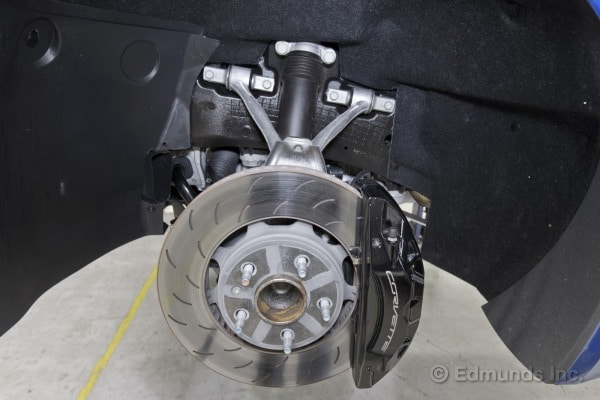
The front of the 2014 Corvette rides on a double-wishbone front suspension. It's the same basic layout found on the last-generation C6, but the geometry has been tweaked and the pieces have been reengineered. It looks similar at a glance but none of the parts are interchangeable.
You can make your own comparisons by opening another window with my 2011 Chevrolet Corvette Z06/Z07 suspension walkaround. If you do, try not to be hypnotized by the massive Z06 brakes. Our 2014 Corvette Stingray is a base car with the Z51 option. It's nothing like a Z06, which will inevitably show up in the future.

Double-wishbone suspension goes by another name that Chevrolet uses on the spec sheet: Short/Long Arm (SLA) suspension. The name comes from the need to make the upper control arm shorter than the lower one in order to create a favorable camber curve so the face of the heavily loaded outside tire stays in full contact with the road in corners.
And just about everything is made of aluminum, including the frame that the upper control arm and shock absorber are bolted into with tie bars.

The Stingray Z51 package includes magnetorheological dampers with an adaptive control system that makes damping adjustments every 10 milliseconds. That tiny strut (black) is the working end of a position sensor that tells the control computer exactly how the suspension is moving.
Still, this stuff was available last year. This isn't the magic we're looking for.

The C7 Corvette continues on with a transverse composite leaf spring (yellow) that presses against the lower control arm.
This height adjuster (green) is a nice feature of this layout, and a Corvette has one at each corner. Twirl all four and you can lower the car. Tweak selected ones while the car is sitting on a set of digital pad scales and you can "corner weight" the car to evenly distribute your own mass or optimize the car to suit whatever track or autocross course you might be tackling.

The composite spring runs underneath the car in about the lowest position you could possibly imagine. And it's made of a lightweight glass fiber composite that doesn't weigh much to begin with. Imagine the weight of a like-size hunk of hardwood and you'll be in the ballpark.

Both sides share a single spring that spans the width of the car, which is what makes it a transverse composite leaf spring.
GM prefers to emphasize the "transverse" and "composite" aspects while ignoring the horse-and-buggy implications of the term "leaf" spring. We get their point, but this clearly isn't a coil spring, an air spring or a torsion bar. Leaf spring is the term that's left — not that there's anything wrong with that.

The transverse leaf is always loaded up against the subframe, even when the car is up in the air with the wheels dangling like it is here. That's why these retaining clips can be so small; they're not shouldering much real load, even now.

There's no need for bulky reinforced towers up high when the spring sits down low, and the shock loads are directed right into the side of the frame itself. And so we get the familiar Corvette front end styling, with its Batmobile fenders and ultra-low hood that settles between them. The center of gravity of the suspension is mighty low, too.
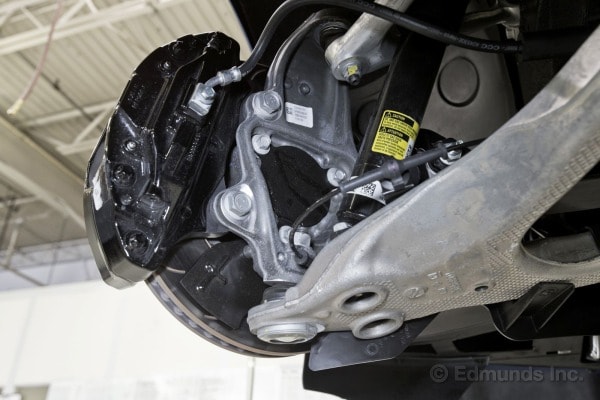
The front knuckle is made of aluminum, too. No surprise there.

Other non-surprises include the Corvette's forward front stabilizer bar routing, short connecting link (yellow) and front-mounted steering rack (green). This time the steering is boosted by an electric motor instead of hydraulics. The steering is tuned well and feels quite good, but that's still not the magic ingredient. Consider it seasoning instead.

We had to remove a plastic air deflector to reveal the details in the last shot, but here you can see how it redirects cooling air in the direction of the brake rotors.
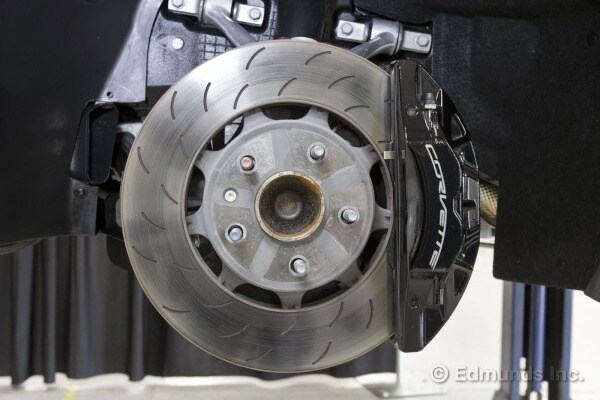
These 13.6-inch ventilated front brake rotors have cooling tricks of their own in the form of surface slots and a spoked hub/rotor interface that looks like a two-piece design, but isn't. Stingrays that lack the Z51 option get smaller 12.6-inch ventilated rotors with no slots.
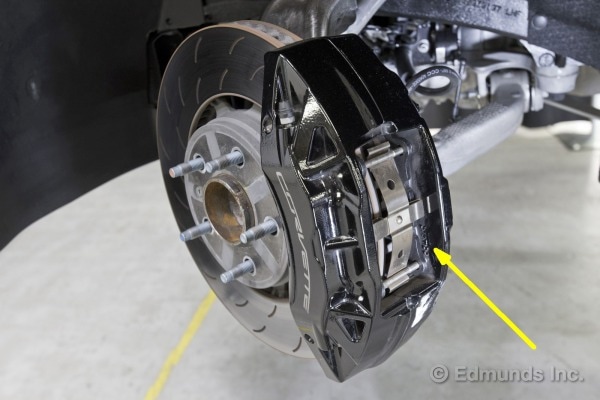
The front calipers are four-piston Brembo units, as evidenced by the small logo just inside the pad extraction window.
These brakes made short work of our stopping distance test, where they never exhibited any fade. But they did get stinky after pounding around the Lutzring again and again. There's room for a Z06-style upgrade here for track-focused customers, and GM will undoubtedly deliver the goods as they roll hotter versions of this machine in the coming months.

It's worth pausing in the middle before we move on to the back. The dual exhausts and the torque tube that connects the engine to the rear transaxle are concealed behind an aluminum stiffening panel that boxes the tunnel. This is new, and the massive increase in C7 chassis stiffness is due in part to this construction. In this we're seeing at least one reason why the C7 Stingray performs so well.
The resulting enclosure is lined with a ridiculously light and thin (and expensive) aerospace-derived Aerogel "frozen smoke" material that keeps the confined heat from radiating up into the passenger compartment. Josh and I can confirm that it works after stressing the engine for extended periods.
And yes, I see the lift arms, too. The borrowed lift came with borrowed lift operators, and the guy on the left apparently didn't agree with the guy on the right.

As before, the 2014 Corvette's rear suspension is an SLA-type double-wishbone arrangement.

The toe-control link sits behind the axle centerline.

This view of the toe link (blue) shows that it's about as long as the lower control arm. But it's much longer than the barely visible upper wishbone, so a small dose of roll understeer will still enter the fray as the outer suspension compresses in roll.
How does this work? In compression the short upper arm pulls the knuckle inward at the top by the scruff of the upper ball joint to increase negative camber, but the long toe link is positioned so that it forces the knuckle to pivot inward at the front as it does this. Still not seeing it? Stare at the toe link's position in the next photo while you work it out in pantomime.
Meanwhile, farther down, the shock absorber's motion ratio relative to the control arm looks to be about 0.9-to-1. But its dramatic lean angle, which gets more dramatic when the suspension is loaded on the ground, cuts that down significantly to something like 0.6- or 0.7-to-1.

Another transverse composite leaf spring is on the job back here, too.

As we saw before, a transverse composite leaf spring spans the width of the car and serves both sides. Interestingly, this makes the transverse spring itself something of an antiroll bar, enough so that the base Corvette without the Z51 package doesn't even have a stand-alone rear antiroll bar.
Huh, you say? Imagine pushing up on one end of the leaf, pretending you're the outside tire under load in a corner. A standing wave is created in the spring through the middle to the other side, causing the far end of the spring to move slightly in the same direction in sympathy. This action counters the tendency of the inside tire to unweight and droop down in corners, just like a stabilizer bar.
The effect isn't large enough to produce enough total roll stiffness for higher-performance suspension options like the Z51, which is why you're catching glimpses of an antiroll bar on this particular car.
So far the advantages of the Corvette's transverse composite leaf spring include these: very low weight; very low unspring weight; no need for reinforced structures up high; low center of gravity; height and corner weight adjustability; built-in roll stiffness that reduces the size and weight of any add-on stabilizer bar that may be desired.

Here's a great view of one of the height/preload adjusters built into the spring attachment points. There's quite a bit of available adjustment range. Close the gap and you're lowering the car. But a little goes a long way because the motion ratio is something like 0.7-to-1 or thereabouts.
But you don't want to be too enthusiastic about slamming your Vette in this way. Your typical lowering springs are stiffer in an attempt to keep the lowered suspension from constantly crashing into the bump stops. Here there's no extra stiffness when you go low, so bottoming is harder to avoid.
And this leads us to the primary disadvantage of GM's transverse composite leaf springs: There's no aftermarket support if you want to play around with spring rates. If GM doesn't make it, it probably doesn't exist. Such springs are expensive to make, and the engineering required to make them in the first place took GM years to work out.
Still, after driving this car, I'm not sure the lack of aftermarket support matters. The suspension works amazingly well as is. I don't want to touch it.

Eccentric cams are used for alignment adjustments. There's another one on the inboard end of the inner end of the toe link, too.

The centerpiece of the Stingray Z51, the component that does more to explain its elevated performance than any other single change, is hidden above the spring and surrounded by some beautiful component packaging. It's a new electronic limited-slip differential, but GM calls it an eLSD for short.
In reality it's an electronically controlled hydraulic wet multiplate clutch pack. It's able to run fully open (zero torque resistance), virtually locked (2,000 Newton-meters, a.k.a. 1,475 pound-feet of resistance) and any point in between. Though it's impossible to feel it working, the eLSD is making adjustments every 11 milliseconds based on feedback from the steering, suspension, ESC, powertrain management system and a new patented tire temperature sensing system.
And so the Corvette Z51 turns eagerly into the tightest autocross corners, hunting apexes as if on a search-and-destroy mission. The tail stays in line midcorner as we add throttle and it doesn't kick out on exit unless we get really stupid with the throttle with all the nannies turned off in Race mode. A lot of what we like about the C7 Z51 has to do with this eLSD.

The hydraulic pump that supplies the eLSD lives behind the left rear fender.
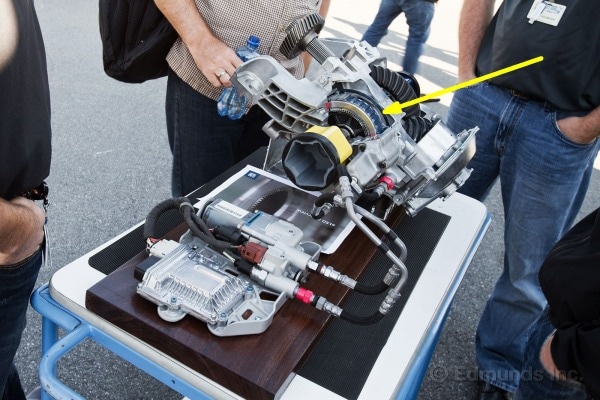
Here's what the eLSD and the hydraulic pump look like out of the car. My yellow arrow is pointing out the multiplate wet clutch that regulates the tightness of the differential action. The continuously variable clamping force it generates is where the resistive torque between the left and right rear tires comes from.
That clamping force is produced by hydraulic pressure that's generated by the pump in the foreground and throttled by control valves that are managed by an ECU that sits in close proximity. This ECU does not act alone, though; it gets additional guidance from the main powertrain ECU and other subsystems.
But the differential itself is not pressurized by this pump. The hydraulic circuit and the diff oil in which the clutch pack is submerged never mix. A similar set of hoses sprouts from the far (passenger) side of the diff housing to circulate hot diff oil to a cooler mounted in the right-rear fender. Its position is more or less opposite the position of the hydraulic works we see here.

Suspension position sensors are attached at the rear, too. All four corners need them to support the fancy magnetorheological dampers and other systems.

The transaxle mounts are more than simple rubber pucks. And check out that hollow subframe casting.

A functional brake duct sprays cool air onto the 13.3-inch ventilated rear rotors. The size is the same on a base C7, but only the Z51 has the surface slots. The calipers are four-piston Brembos.

The astounding grip and stopping distance we measured wouldn't be possible without excellent tires. These new Michelin Pilot Super Sport run-flats deserve a lot of credit.
They're not crazy wide. The P245/35R19 front and P285/30R20 rears on our Z51 are no fatter than those on the base 2014 Corvette or last year's base C6. And yet the 2014 Corvette Stingray makes numbers that rival those of last year's wide-body Vettes running P285 front and P335 rear rubber.
And these new Michelins are not R-compound specials. They carry a fairly pedestrian treadwear rating of 300.
Mounted and ready to roll, the P245 front assemblies weigh 51.5 pounds and the P285 rear units weigh 60 pounds. You thought we were going to forget that on this field trip walkaround, but it turns out they have UPS scales in Michigan, too.
In the end the 2014 Chevrolet Corvette's performance seems to come down to grippy tires, a fantastic eLSD differential and vastly improved chassis stiffness. Chassis tuning and geometry refinement play a part, but those changes seem more evolution than revolution.
It adds up to a 2014 Chevrolet Corvette Stingray that is very desirable indeed, especially with the Z51 suspension option. This is the first Corvette I've ever driven that made me want to join the club, and this tour underneath only made me want one that much more.
